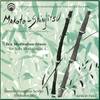

Playlist: Classical Genres of Japan (Introduction to World Music: Asia) by Jenna Makowski, Alexander Street Press
The pieces in this playlist cover a range of classical music genres of Japan, including Gagaku, Sankyoko, Honkyoku, solo koto, and hayashi ensembles of Noh theater. Collectively, this selection speaks to the century's deep history of classical music in Japan and are representative examples of the concept of "ma", or open space, created in music and art.
Format
Artwork
Title
Notes
Duration / Pages
Date added
Etenraku
performed by Kyoto Imperial Court Music Orchestra; in Gagaku: The Imperial Court Music of Japan (Lyrichord), 8 mins
Etenraku is a piece from the Gagaku repertoire. Gagaku, the imperial court music of Japan, has been preserved under the patronage of the court since the sixth century. This is the best-known piece in Gagaku repertoire, the music frequently used as an accompaniment to songs in the Heian Period (794-1185). The composition consists of three melodic phrases of 32 beats each. (Gagaku: The Imperial Court Music of Japan. Liner Notes. Lyrichord, 1993.)
08:06
26 Dec 2013
This is the prelude to one of the oldest pieces in the Gagaku repertoire. Listen for characteristic elements of the genre, including free rhythm, thin textures that create a sense of open space, and the taiko drum. (Gagaku Suites. Liner Notes. Celestial Harmonies, 2002.)
08:25
26 Dec 2013
Rokudan
performed by Yoshimura Nanae; in The Art Of The Koto, Vol. 1: Works From The Edo Period (Celestial Harmonies, 2000), 6 mins
The koto belongs to the family of long zithers, found across East Asia. The instrument's classical repertoire peaked from the mid-17th to the mid-19th century, during the Edo period. Rokudan is the best known piece from this era. The piece is based on a variation style, which became fundamental to the genre. It is performed in such a way that the tempo increases gradually towards the final section, with a strong ritardando at the end. (Nanae Yoshimura: The Art of the Koto, Vol. 1. Liner Notes. Celestial Harmonies, 2000.)
06:18
26 Dec 2013
Shochikubai
performed by Sadako Nishimura, fl. 1990, Hiroko Mitsuike, fl. 1990 and Shukin Noda, fl. 1990, Ikuta School Koto ensemble; in Japanese Koto Orchestra (Lyrichord, 1993), 10 mins
The koto can also function as an ensemble instrument, in this case in Sankyoku, or music for three instruments. This particular piece, a trio for koto, shamisen and shakuhachi, was composed by Mitsuhashi Koto and is representative of the classic form of composition. Sho, the pine tree, represents ever-lasting prosperity; Chiku, the bamboo, symbolizes formality and honesty; and Bai, the plum blossom, represents elegance. (Japanese Koto Orchestra. Liner Notes. Lyrichord, 1993.)
09:45
26 Dec 2013
Daiwa-Gaku
produced by Jorge Alfano; performed by Ronnie Nyogetsu Seldin; in Makoto Sjinjitsu: Ronnie Nyogetsu Seldin (Lyrichord, 1998), 4 mins
Daiwa-Gaku is a piece composed by the great Shakuhachi master of the 20th century, Jin Nyodo. The piece is one of the few that have been composed in the modern era, and have been accepted into the ranks of the great traditional Honkyoku, a genre of shakuhachi played by Japanese zen monks since the 13th century. The piece is intended to speak to the four seasons of the year, the four times of day, and the four stages of a man's life. (Makoto Sjinjitsu: Ronnie Nyogetsu Seldin. Liner Notes. Lyrichord, 1998.)
03:52
26 Dec 2013
Kagekiyo, Part 1
produced by Jacob Feuerring, 1912-1979; in Noh and Kyogen Plays Live (Folkways Records, 1969), 27 mins
This track is meant to accompany the first section of a Noh play, a genre of highly structured and stylized classical Japanese theater. Kagekiyo is an emotional play describing the emotions of a father and daughter who, after long years of separation, part forever. The accompanying ensemble consists of a bamboo flute and three drums. Listen for an extreme representation of the concept of "ma", or open space. (Noh and Kyogen Plays Live. Liner Notes. Folkways Records, 1969.)
27:26
26 Dec 2013
Delete playlist item?






